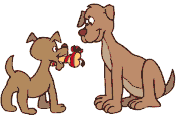Approaching Dogs / Greeting Behaviour.
by Lotte Griffiths – Accredited Behaviour Consultant (Canine) (ABC of SA™)
.

A fair amount of aggressive behaviour can be avoided simply by behaving appropriately whenever you approach an unfamiliar dog. Humans often greet dogs just as they would greet children and other humans. So what, may you say, is wrong with human greetings? Well nothing … provided you are a human, but unfortunately a typical “human” greeting is generally offensive in the extreme, if you happen to be an unfamiliar dog and, in extreme circumstances could trigger an attack!
Think for a moment about how you behave when you meet another person. You probably move directly towards him or her and, with a smile, look directly into their eyes / face and the person you are greeting will usually interpret this as you being friendly. Then you might reach out with your hand to shake the other persons’ hand and, if you know them well enough, you may embrace, hug or perhaps even move your face close to his/hers and kiss cheeks or lips. This, in human terms, is quite acceptable; it is the way in which you might greet your mother, friend or colleague.
Now let us examining how dogs greet each other:
Unless they dogs know each other exceedingly well (e.g. pack- or regular play mates) and depending somewhat on individual temperament and social status and on whether or not they wish to appear challenging, upon seeing another dog, ‘polite’ dogs will usually avert their eyes, because 'staring' at another dog is a challenge!
Next, they may approach the other dog in a curved line or, if they are very low-ranking, belly-crawl towards the other dog. Alternatively, they may wait politely for the other dog to approach. Next the dogs will usually sniff each others’ genital area to learn more about the other dog's social and reproductive status, etc. Only after these initial greeting procedures has been completed, will they (perhaps) sniff and/or even lick the other dog’s face or lips, signal a play-bow and begin to play. Therefore, whenever you meet an unfamiliar dog, it is always prudent to indicate to the dog, in a manner which the dog can understand, that you do not intend it or its owner any harm … and no, I don’t expect you to sniff genitals.
1. Make yourself and your eyes ‘small’ and avert your eyes and face (you can still peek out of the corners)
2. Use a curved rather than a straight line for your approach and stop before you reach the dog. Keep your hands by your side (tuck your finger in!), place your weight distribution onto your heels and allow the dog to make the decision as to whether or not he would like to come close to you.
3. Only if or when the dog approaches you, perhaps to sniff your hands, should you even consider greeting him and when/if you do so, remember not reach over him as that may also be interpreted as a challenge.
Think for a moment about how you behave when you meet another person. You probably move directly towards him or her and, with a smile, look directly into their eyes / face and the person you are greeting will usually interpret this as you being friendly. Then you might reach out with your hand to shake the other persons’ hand and, if you know them well enough, you may embrace, hug or perhaps even move your face close to his/hers and kiss cheeks or lips. This, in human terms, is quite acceptable; it is the way in which you might greet your mother, friend or colleague.
Now let us examining how dogs greet each other:
Unless they dogs know each other exceedingly well (e.g. pack- or regular play mates) and depending somewhat on individual temperament and social status and on whether or not they wish to appear challenging, upon seeing another dog, ‘polite’ dogs will usually avert their eyes, because 'staring' at another dog is a challenge!
Next, they may approach the other dog in a curved line or, if they are very low-ranking, belly-crawl towards the other dog. Alternatively, they may wait politely for the other dog to approach. Next the dogs will usually sniff each others’ genital area to learn more about the other dog's social and reproductive status, etc. Only after these initial greeting procedures has been completed, will they (perhaps) sniff and/or even lick the other dog’s face or lips, signal a play-bow and begin to play. Therefore, whenever you meet an unfamiliar dog, it is always prudent to indicate to the dog, in a manner which the dog can understand, that you do not intend it or its owner any harm … and no, I don’t expect you to sniff genitals.
1. Make yourself and your eyes ‘small’ and avert your eyes and face (you can still peek out of the corners)
2. Use a curved rather than a straight line for your approach and stop before you reach the dog. Keep your hands by your side (tuck your finger in!), place your weight distribution onto your heels and allow the dog to make the decision as to whether or not he would like to come close to you.
3. Only if or when the dog approaches you, perhaps to sniff your hands, should you even consider greeting him and when/if you do so, remember not reach over him as that may also be interpreted as a challenge.
This article is copyrighted and remains the property of the author. Individuals are welcome to print or copy same for their own use in furthering their knowledge of dogs. However, no reproductions or alterations/variations are allowed without the express written consent of the author
